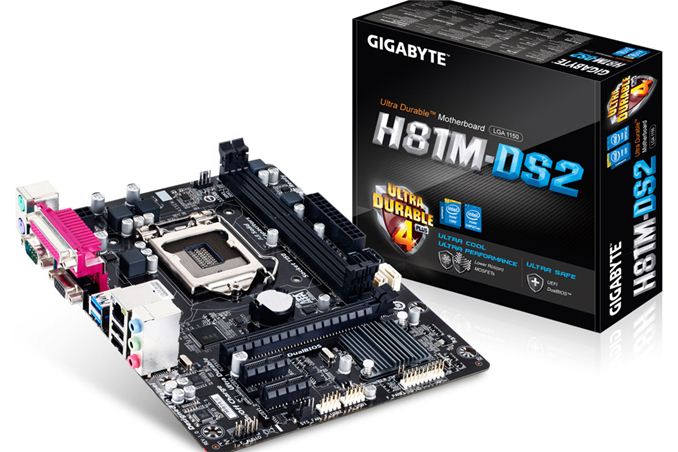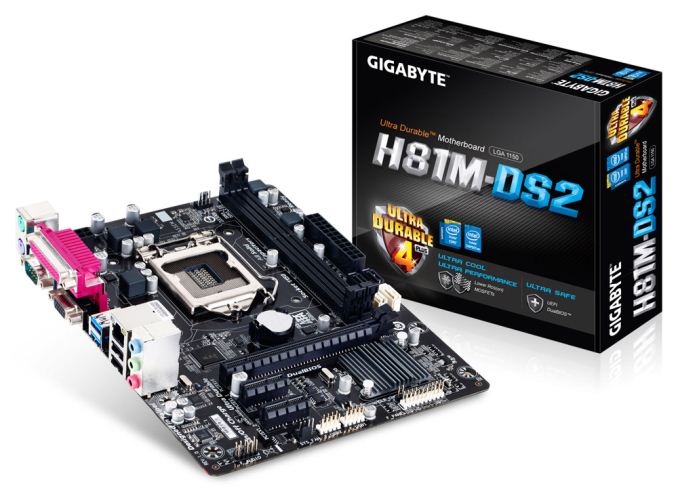GIGABYTE Launch H81 Series Motherboards
by Ian Cutress on August 24, 2013 7:31 AM EST- Posted in
- Motherboards
- Gigabyte
- Haswell
- H81

When it comes to our motherboard reviews, we typically attempt to focus on the high sellers with distinguishing features - this normally means chipsets aimed at the mainstream to high end with more capabilities. Every so often we touch on something aimed more at the entry level or a cheaper chipset, and today GIGABYTE are launching their H81 series motherboards - entry level for Haswell.
To put H81 into perspective, the chipset offers two SATA 6 Gbps ports, two USB 3.0 ports, no RAID, no Smart Response Technology, a single PCIe 2.0 x16 from the CPU and six PCIe 2.0 lanes from the chipset.
GIGABYTE's H81 range covers both thinner ATX and micro-ATX motherboards, where PCIe 2.0 x1 and PCI ports occupy the extra slots down the motherboard. The range will have seven SKUs, four of which are available online:
| GA-H81-D3 | GA-H81M-S2PV | GA-H81M-S2PH | GA-H81M-DS2 |
| GA-H81M-HD3 | H81M-H | H81.AMP-UP |
All the motherboards will feature Ultra Durable 4 PLUS, which means 40A IR3550 ICs in the power delivery (all boards seem to feature a 2+1 VRM arrangement), as well as the new HD BIOS and GIGABYTE App Center which we examined on Z87. GIGABYTE state that some models will also be equipped with a USB 3.0 hub to increase USB 3.0 ports up to six, although none of the four models currently online do so, thus it seems reserved for the H/HD versions. All the online models contain Realtek NICs and audio codecs, as well as either a serial or a parallel port or both:
No word on pricing or which regions these motherboards will be aimed for. The interesting part from this PR is the H81.AMP-UP model, which would suggest that some of the G1.Sniper Z87 or A88X features are coming to H81: either the OP-AMP (adjustable amplifier) or USB DAC-UP (cleaner USB power for DACs) or both. This could potentially be good news, as typically entry-level chipsets are paired with ALC887 codecs or similar.
I rarely (once or twice a year) get requests to review motherboards based on entry-level chipsets - there is not much to test and rarely anything new for comparison or explanation. However this PR gives an opportunity to ask our readers if you would be interested in such a review?
Update 08/25: Since the initial PR, GIGABYTE have upped the number of H81 motherboards to 10:
This list now includes access to the HD3, the D2V, and D3V, all of which feature the USB 3.0 hub as mentioned in the original PR.

















24 Comments
View All Comments
taisingera - Saturday, August 24, 2013 - link
For a couple of bucks more the B85 motherboards look much more interesting.ThomasS31 - Saturday, August 24, 2013 - link
Can these also change multipliers on K series? Usually the interesting question on these is can you build a cheap gaming OC setup with them for a moderate Haswell OC setup, like i5 4670K @ 4GHz... and a single GPU? Or you need to spend (sometimes a lot) more on motherboards to get there a pay for something you will probably never utilize? I am interested from this perspective on cheap/budget boards. :)georgefrs - Saturday, August 24, 2013 - link
Given the lack of comparison points I'm not sure a full review would provide us with an objective measure. How about a comparison of 2 or 3 H81 boards? (assuming you can get boards from other manufacturers and Gigabyte et al don't mind you doing a "round up" style review).Some coverage of H81 would certainly be beneficial anyway... a quick look on reddit.com/r/buildapc and similar sites shows there are a lot of system builders on tight budgets and they tend to cut corners by building around boards such as this!
mfenn - Saturday, August 24, 2013 - link
A roundup would be helpful in determining if a B85/H81 is truly a cut corner or is actually a good value.andykins - Sunday, August 25, 2013 - link
The expensive motherboards seem like a waste of money for my personal needs. I'd love to see more reviews of the low end boards to see whether I am right about that or not.StormyParis - Saturday, August 24, 2013 - link
Yes I would.I build PCs for the people around me. Most are adults, seniors or kids, and just went something run-of-mill, cheap (and small and quiet too thank you). This board is exactmly the type of board I'm buying blind several times a year because all review sites are run by geeks for geeks, and and don't cater at all to anyone outside of the 15-29 gamer/young adult demographics who want rooxorz buildz to overclock their watercooled multiGPU setups built with someone else's money. Oh, and flashy lights plizzzz :-p
et20 - Saturday, August 24, 2013 - link
I fully agree.I have zero interest in overclocking, RAID, SRT and whatever alphabet soup of useless technologies Intel bloats their chipsets with these days.
There's no need for the typical long detailed reviews we typically get here.
Something that focuses on the quality differences between a bunch of low end boards would be ideal.
The point would be to identify a set of products that are solidly engineered and safe to buy as opposed to ones that may have sacrificed reliability to get to a lower price point.
DanNeely - Sunday, August 25, 2013 - link
Without doing builds and stability/performance testing an article won't really be any better than looking at specs on newegg; and even if you drop testing raid/etc you've still done most of the work involved in a review.TGMGroup - Saturday, August 24, 2013 - link
Rather than a review, it would be nice to have a chart showing what companies offer what, and how it compares to other competitors. For example, relating Ultra Durable to something that Asus or ECS offers.Which is not to say that I would not find a review enjoyable.
M4stakilla - Saturday, August 24, 2013 - link
I would be very interested in a review of such entry level mobo paired with a i3-4130 (entry level haswell) from a HTPC perspective.Compare them for example to B85 or the cheapest Z87...
And also looking at for example analog stereo outputs (jack/RCA) on the onboard sound card...